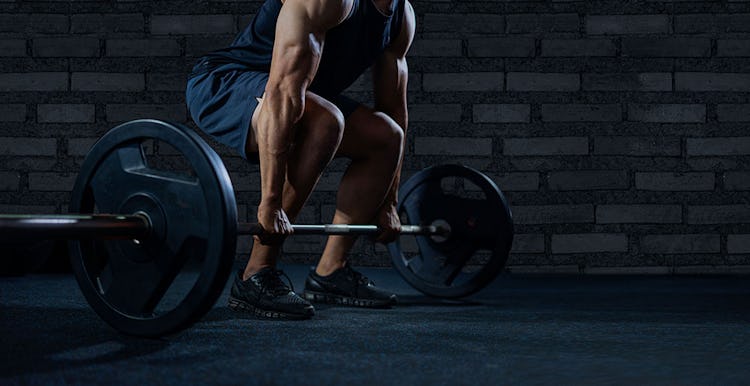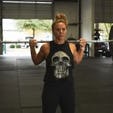The default set- and rep-scheme for most gym-goers seems to be three sets of 10. Why? Because it just works. But serious lifters know that five sets of five—abbreviated as 5×5—often works even better. The 5×5 method was popularized in the 1960s by Reg Park, a multiple-time Mr. Universe and idol to a then up-and-coming bodybuilder named Arnold Schwarzenegger, and it’s never been out of style since.
The following is an excerpt adapted from the Men’s Health Encyclopedia of Muscle, written by Onnit’s Editor-In-Chief, Sean Hyson, CSCS. For more workouts and training tips, pick up the book at Amazon.com.
Why Does 5×5 Work?
The beauty of the 5×5 system is that it’s almost impossible to screw up. Virtually any way you choose to interpret how to do five sets of five is sure to yield some progress. The reason why is the combination of load and volume. Low-rep sets imply pretty heavy weights, and five sets’ worth gives you enough exposure to challenging loads to drive muscle and strength gains.
The big question with 5×5 is just how much weight you should use. Honestly, your best guess is probably good enough. But looking at it scientifically, you can come up with a more refined strategy. Lifting a load that allows you only five reps equates to about 87% of your one-rep max (the heaviest load you can lift for one rep—an all-out effort). However, because you have to do five sets, you’ll need to leave a little in the tank on your first set. If you use the heaviest load that allows you ONLY five reps right away, you’ll have a hard time completing the four sets that follow. Therefore, the weight you choose must be lighter.
C. J. Murphy, a competitive powerlifter and strongman, and owner of Total Performance Sports in Malden, MA, recommends choosing a load that you can get seven or eight reps with. This means about 80% of your max. So, let’s say that you’re pretty sure that you can squat 225 pounds for one rep, if your life depended on it, and you want to do a 5×5 workout. Eighty percent of 225 is 180 pounds, so load 180 for your first set. “Most muscle adaptation occurs with 65 to 85% of your max,” says Murphy. Doing 5×5 this way puts you at the north end of that range, making it an excellent approach for building size, but also intense enough to boost strength.
The next question that comes up is whether to keep the same weight every set or add weight each set. The answer is both. “Form is more important than weight,” says Murphy. So, whether you keep the same load or bump it up by a few pounds on one set or every set, every rep should look crisp and smooth. “Most people’s best set is usually their third, fourth, or fifth one,” says Murphy, when the nervous system has been fully activated by the exercise but before fatigue sets in. “So, I might make a small jump in weight on the third set, if it’s going well.” (This could be five or 10 pounds, depending on the exercise.) You’ll have to monitor yourself.
What Exercises Are Used in 5×5 Workouts?

Five by five is typically done on classic multi-joint barbell lifts, such as squats, deadlifts, presses, and rows—exercises that activate great amounts of muscle and work big areas of the body. You shouldn’t attempt 5×5 with isolation movements such as curls, lateral raises, or leg extensions, as those exercises don’t lend themselves to the use of such heavy weights. Trying to curl a load that feels heavy for five reps can easily result in sore elbows or torn biceps over time, so restrict the 5×5 method to your main lift of the workout. Also, as 5×5 is strenuous and can be time consuming, don’t use it for more than three exercises in any one workout.
How Long Does The 5×5 Workout Take?
The length of any strength workout really depends on how strong you are. It takes longer to work up to 365 pounds for squats than it does 225. It’s also important not to rush your sets. Because you’re working with heavy weights, you should allow yourself to recover fully between sets for the sake of safety as well as performance. This could mean two minutes, or longer, depending on the loads used and the complexity of the exercise you’re doing 5×5 on. With all that said, you can expect a workout with two or three exercises done 5×5 style to last anywhere from 30–60 minutes.
One popular method of employing 5×5 is to do three exercises in a session, using 5×5 to train the whole body. For example, you could squat, then bench press, and then finish with a bent-over barbell row. You could come back two days later and perform three similar exercises for another 5×5 session, and then, after another day off, finish the week with a third 5×5 workout. This is a highly-efficient way to train, which makes it good for beginners and those who are young, injury-free, and need practice with barbell lifts to master them. However, it may be too grueling for people over 35 years old, or those with injuries from years of heavy lifting. Murphy believes most people would probably be successful doing one or two 5×5 lifts in a session, and using the protocol for a month or so, and then switching to some other training method for a while.
Is the 5×5 Workout Effective?

The 5×5 workout has been around for at least a half-century, and probably much longer. It’s widely considered to be a good routine for beginners to follow because it’s simple to implement and provides a balance of heavy weights and increasing volume—two factors that are known to produce muscle and strength gains.
A 2016 study in Biology of Sport had subjects perform workouts that alternated 5×5 and six sets of two reps. After five months, their strength gains on the bench press had increased significantly, but researchers determined that the heavier (6×2) regimen was no more effective than the 5×5, and that starting with lighter loads in a progressive long-term program may be the better strategy, as it leads to similar gains with less exertion. This idea fueled the way we prescribe 5×5 in the sample workouts below.
How To Stretch for a 5×5 Workout
Include the following mobility drills in your warmup before performing the sample 5×5 workouts below. Perform each move in sequence, completing 10 reps, and repeat for 3–5 total rounds. See a demonstration for each move in the video.
Chicken wing neck roll – 00:46
Sundial salute – 02:00
Bootstrapper spine roll – 03:55
Mobile table – 06:15
Pigeon switch – 07:55
BONUS: Kneeling pushup elbow circle – 11:03
5×5 Sample Workouts
The following workouts represent our preferred way of performing the 5×5 method.
Do your first set of the 5×5 exercises with a weight that allows you eight reps. If your speed on the first two sets is fast, and your form is good, you may add weight on the third set (and fourth and fifth, if your technique holds up). If your reps move slowly or form breaks down on any set, stop the set there—no matter how many reps you have left—and reduce the weight. Each week, add a little weight to your 5×5 lifts. For upper-body exercises, add 2.5 to 5 pounds, and for lower-body, add 5 to 10.
Murphy recommends using the Rating of Perceived Exertion (RPE) scale to control your intensity. If a 10 represents an all-out effort, do your workouts as follows.
Week 1: 7 RPE (you should have about three reps left in you at the end of every set)
Week 2: 8 RPE (about two reps left)
Week 3: 9 RPE (about one rep)
Week 4: 7 RPE (back off this week to gather energy for next week—i.e., reduce the load by a few pounds so it doesn’t feel so difficult)
Week 5: 10 RPE (increase the weight and go for it!)
You may perform the exercises as straight sets (complete all sets for one lift before moving on to the next) or, if you want to save a few minutes of workout time, alternate sets of any two 5×5 exercises in the workout. (Note that not every exercise in each workout uses this set and rep scheme.) Rest, as needed, between all sets of every exercise, and at least 90 seconds between sets of the 5×5 exercises.
There are three sample workouts here, and they can be done in sequence (for example, Workout I on Modnday, II on Wednesday, and III on Friday). Rest at least one day between each.
Workout I
1. Front Squat
(See 02:17 in the video How To Crush 5×5 Workouts for Huge Gains above.)
Sets: 5 Reps: 5
Step 1. Grasp the bar with hands shoulder-width apart and point your elbows forward so that you can position the bar over the tips of your fingers (palms face up). As long as you keep your elbows pointing forward, you will be able to balance the bar.
Another way to do it is to cross your arms in front of you, holding the bar on the front of your shoulders (left hand in front of right shoulder, right hand in front of left). To do the classic front squat with the bar on your fingertips, you need a reasonable amount of flexibility through your shoulders and wrists to position the barbell correctly. If you don’t have it, the cross-arm version may be the better option for you at the moment, but another option is to use wrist straps if you have them. Loop the straps around the bar and grasp the open ends with each hand, and then rest the bar on your shoulders (see the “How To Crush 5×5 Workouts For Huge Gains video above).
Step 2. Lift the bar out of the rack and step back, setting your feet between hip- and shoulder-width apart. Turn your toes out slightly. Without letting your feet actually move, try to screw both legs into the floor as if you were standing on grass and wanted to twist it up—you’ll feel your glutes tighten and the arches in your feet rise.
Step 3. Pull your ribs down and take a deep breath into your belly and brace your core. Your head, spine, and pelvis should form a long line—your pelvis should also be perpendicular to your spine, and not tilted toward the floor. Focus your eyes on a point straight in front of you.
Step 4. Squat as low as you can while keeping alignment and maintaining your upright torso position. Remember to point your elbows forward, and raise them up if you feel them slipping downward. Ideally, you’ll be able to descend to where the crease of your hips is below the top of your thighs.
Your knees must stay in line with your toes. Trying to push them out and actively root your feet into the ground will all but ensure this.
Step 5. Extend your hips and knees to return to standing, pushing through the middle of your feet and squeezing your glutes.
2. Chinup
(See 03:37 in the video.)
Sets: 5 Reps: 5
Step 1. Hang from a bar with your hands shoulder-width apart and your palms facing you. Pull your ribs down and keep your core tight.
Step 2. Draw your shoulder blades back and together and pull yourself up until your chin is over the bar. If your bodyweight isn’t challenging enough, attach extra weight with a belt, or hold a dumbbell between your feet.
3. Overhead Press
(See 04:23 in the video.)
Sets: 5 Reps: 5
Step 1. Hold a barbell with hands shoulder-width apart. You can take the bar off a rack, or, if you don’t have one, simply pick the bar up off the floor and clean it to shoulder level. Stand with feet shoulder-width apart and tuck your tailbone slightly so that your pelvis is parallel to the floor. Draw your ribs down and brace your core.
Step 2. Press the bar overhead, pushing your head forward as the bar clears it so that the bar ends up just behind your head in the lockout position.

Pick up The Men’s Health Encyclopedia of Muscle at Amazon.com.
Workout II
1. Deadlift
(See 02:04 in the video above.)
Sets: 5 Reps: 5
Step 1. Stand with feet hip-width apart and tilt your tailbone back. Bend your hips back to reach down and grasp the bar with hands just outside your knees.
Step 2. Keeping a long spine with your head in line with your hips, take a deep breath into your belly, brace your abs, and drive through your heels. Pull the bar up along your shins until you’re standing with hips fully extended and the bar is in front of your thighs. Keep the bar pulled in tight to your body the whole time with your shoulder blades pulled together and down (think “proud chest”).
If you can’t keep your lower back flat throughout the exercise, it’s OK to elevate the bar on some weight plates or mats.
2. Incline Dumbbell Press
(See 02:40 in the video.)
Sets: 3 Reps: 8–12
Step 1: Set an incline bench to a 30- to 45-degree angle and lie back on the bench holding dumbbells at arm’s length above your chest.
Step 2: Lower the dumbbells until they are close to the sides of your chest. In the down position, your elbows should be at a 45-degree angle to your torso—not straight out to the sides.
Step 3: Press the dumbbells back up, flexing your chest as you push.
3. Face Pull
(See 03:00 in the video.)
Sets: 3 Reps: 12–15
Step 1. Attach a rope handle to the top pulley of a cable station. Grasp an end in each hand with your palms facing each other. Step back to place tension on the cable.
Step 2. Draw your shoulder blades together and down as you pull the handle to your forehead, so your palms face your ears and your upper back is fully contracted.
Workout III
1. Bench Press
(See 03:30 in the video.)
Sets: 5 Reps: 5
Step 1. Lie on the bench and arch your back, pulling your shoulder blades down and together. Grasp the bar just wider than shoulder width, and pull it out of the rack.
Step 2. Take a deep breath, tighten your glutes, and lower the bar to your sternum, tucking your elbows to your sides at 45 degrees on the descent. When the bar touches your body, push your feet into the floor and press the bar up at the same time.
2. Bent-Over Row
(See 04:20 in the video.)
Sets: 5 Reps: 5
Step 1. Place a barbell on a rack set to hip level, or deadlift it off the floor. Grasp the bar with your hands at shoulder width and set your feet at hip width; hold the bar at arm’s length against your thighs. Take a deep breath, and bend your hips back—keep your head, spine, and pelvis aligned. Bend until your torso is nearly parallel to the floor.
Step 2. Draw your shoulder blades together as you pull the bar up to your belly button.
3. Hip Thrust
(See 04:50 in the video.)
Sets: 5 Reps: 5
Step 1. Load a barbell on the floor. Lie with your upper back resting on a bench and your legs flat on the floor in front of you. Roll the bar into the crease of your hips (you may want a pad or towel to cushion it), and hold it on each side. Place your feet flat on the floor, hip-width apart, and turn your toes out slightly.
Step 2. Brace your abs and push your hips up, driving through your heels until your torso and hips are parallel to the floor.

)





